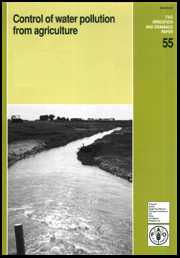
by
Edwin D. Ongley
GEMS/Water Collaborating Centre
Canada Centre for Inland Waters
Burlington, Canada
Food and Agriculture Organization of the United Nations
Rome, 1996
|
The designations employed and the presentation of material in this publication do not imply the expression of any opinion whatsoever on the part of the Food and Agriculture Organization of the United Nations concerning the legal status of any country, territory, city or area or of its authorities, or concerning the delimitation of its frontiers or boundaries. |
M-56
ISBN 92-5-103875-9
All rights reserved. No part of this publication may be reproduced, stored in a retrieval system, or transmitted in any form or by any means, electronic, mechanical, photocopying or otherwise, without the prior permission of the copyright owner. Applications for such permission, with a statement of the purpose and extent of the reproduction, should be addressed to the Director, Information Division, Food and Agriculture Organization of the United Nations, Viale delle Terme di Caracalla, 00100 Rome, Italy.
© FAO 1996
This electronic document has been scanned using optical character recognition (OCR) software and careful manual recorrection. Even if the quality of digitalisation is high, the FAO declines all responsibility for any discrepancies that may exist between the present document and its original printed version.
Acronyms of institutes and programmes
Chapter 1: Introduction to agricultural water pollution
Water quality as a global issue
Non-point source pollution defined
Scope of the problem
Agricultural impacts on water qualityTypes of impacts
Irrigation impacts on surface water quality
Public health impacts
Data on agricultural water pollution in developing countriesTypes of decisions in agriculture for non-point source pollution control
The data problem
Chapter 2: Pollution by sediments
Sediment as a physical pollutant
Sediment as a chemical pollutant
Key processes: Precipitation and runoff
Key conceptsMeasurement and prediction of sediment loss
Chapter 3: Fertilizers as water pollutants
Eutrophication of surface waters
Environmental chemistry
The point versus non-point source dilemma
Management of water quality impacts from fertilizersEconomics of control of fertilizer runoff
Aquaculture
Problems of restoration of eutrophic lakes
Chapter 4: Pesticides as water pollutants
Historical development of pesticides
North-south dilemma over pesticide economics
Fate and effects of pesticidesFactors affecting pesticide toxicity in aquatic systems
Human health effects of pesticides
Ecological effects of pesticides
Natural factors that degrade pesticidesPesticide monitoring in surface water
Pesticide management and control
The European experience
Pesticide registration
The Danish example
Pesticides and water quality in the developing countries
Chapter 5: Summary and recommendations
Necessity to internalize costs at the farm level
Integrated national water quality management
Assessment methodology
Environmental capacity
The data problem in water quality
Water quality indices for application to agricultural water quality issues
Economic analysis of cost of water pollution attributed to agriculture
Information technology and decision making
Use of water quality objectives
FAO and the POPs agenda
Pesticides in developing countries